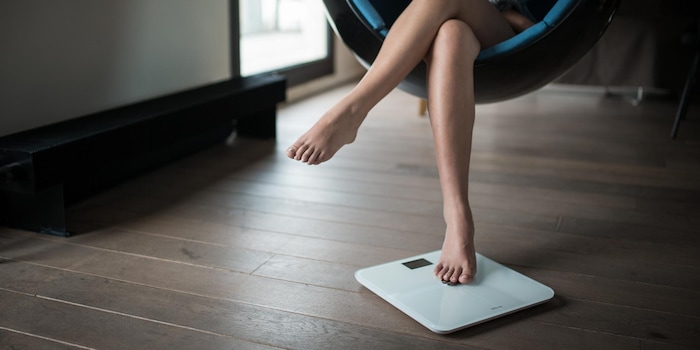

Accurate to the gramme: Body fat scales put to the test
“Is that water or fat I’ve lost?”, “Has my muscle mass increased?”. Body fat scales answer these kinds of questions. German consumer magazine “ETM Testmagazin” tested and compared ten models. Find out how the tests were carried out and how the various models performed.
Having a healthy body is becoming increasingly important to many people. Scales manufacturers have reacted to this trend and developed body fat scales. They no longer only measure weight but also the percentage of fat, muscle and water in the body. But how good are these newfangled scales? “ETM Testmagazin” took a closer look at ten models and their corresponding apps and rated various aspects.
How body fat scales work
Body fat scales make use of the fact that water conducts electricity. Metal electrodes send a weak, non-perceivable electrical impulse through the feet. The different kinds of tissue contain different amounts of water. In other words, not every type of tissue conducts electricity equally. The results also consider other values – these include body height, sex, age and the degree of physical activity. The disadvantage of these scales is that only foot electrodes are used for the measuring. The current takes the shortest distance between one electrode to the other. This means that the current flows from one foot to the other and only measures the lower part of the body. Therefore, the measurement results should not be interpreted as absolute values but as approximate values. So if you are following a diet or are regularly working out, these approximate values will simply show a trend.
Testing method and criteria
Function (60% emphasis):
The measuring accuracy was tested by using calibrated weights to simulate weight changes. To this end, the test persons stood on the scales several times consecutively to precisely establish their initial weight. Subsequently, they were each given different weights before re-establishing their “new” weight. To test the measuring accuracy regarding the percentage of fat, sports physicians first carried out a reference measurement (bioempedance analysis). Following this, any deviations of the measured values from the reference values were established and assessed. Furthermore, the data evaluation by means of the app was also considered. This included the testing and rating of the installation, the data transfer and the presentation of the measured values via the app.
Handling (20% emphasis):
The category “handling” tested the ease of use of the scales. This included aspects such as programming users, number of adjustable users as well as changing parameters such as weighing units. What’s more, the readability of the display was tested in different lighting conditions. Finally, the documentation was also tested for external (graphic) criteria and content.
Features (10% emphasis):
The scales’ range of functions together with its corresponding app were rated. Apart from weight and fat percentage, some models also establish and display additional parameters including body water, muscle mass, bone mass, BMI. Furthermore, the finish of all product materials was rated.
Safety (10% emphasis):
To rate the safety of the scales, their stability was tested. This was done by putting a strain on the edge of the scales.
The test result
1. place: Medisana BS 430
The scales are easy to use and determine precise values as regards weight and fat percentage. Furthermore, the app not only provides good insights into the various measurement values but also impresses with tips and other additional functions.
Overall verdict: “Excellent” (94.62%)
Handling: 93.50%, features: 96.96%, function 94.88%, safety: 93.00%
Pros: Precise measuring, fast data transfer, excellent stability
Cons: -

2. place: Withings Body
The values shown on the display are easy to read. The corresponding app is innovative to use. A position control feature tells the user if he or she is standing correctly.
Overall verdict: “Excellent” (94.08%)
Handling: 92.45%, features: 92.16%, function: 95.05%, safety: 88.50%
Pros: Precise measuring, clearly displays data
Cons: delayed data transfer to the app
4. place: iHealth Core HS6
iHealth’s model impresses with the largest range of features. It even displays visceral fat (fat stored around the organs).
Overall verdict: “Excellent” (92.93%)
Handling: 90.15%, features: 97.20%, function: 93.13%, safety: 93.00%
Pros: Precise measuring, measures visceral fat, temperature and humidity display
Cons: Highest deviation in the fat analysis
7. place: FitBit Aria
These body fat scales do what they should and only display body weight. Other measurements are shown in the app.
Overall verdict: “Good” (89.24%)
Handling: 85.75%, features: 87.16%, function: 91.30%, safety: 86.00%
Pros: Precise measuring
Cons: Small range of functions
The practical test – additional facts
Features
- All scales include batteries.
- The withings scales additionally displays the weather and temperature.
- Not all models allow you to set the user profile via physical control elements.
Handling
- Many models allow you to set the measurement unit (kg, lb or st) via a button.
- The Smartlab and Withings models include optional feet for the use on carpeted floors.
- With the exception of the Withings model, all feet are made of rubber for extra sturdiness.
App
- Some apps motivate users by means of e.g. badges for reaching targets.
- All apps are able to display measuring values in tables.
- Almost all apps display the measurement curve by means of graphs.
Go to "ETM Testmagazin" test report (in German)
Friends, family, cats and good wine are my lifeblood.


